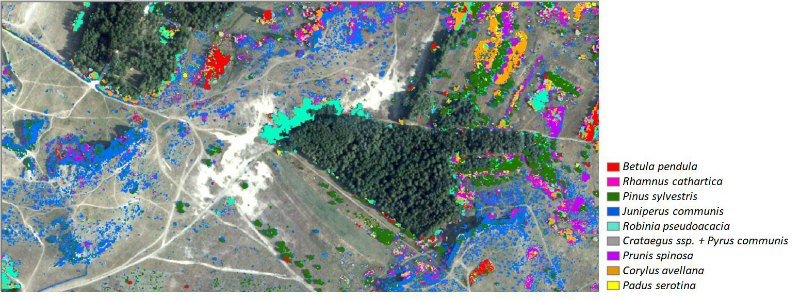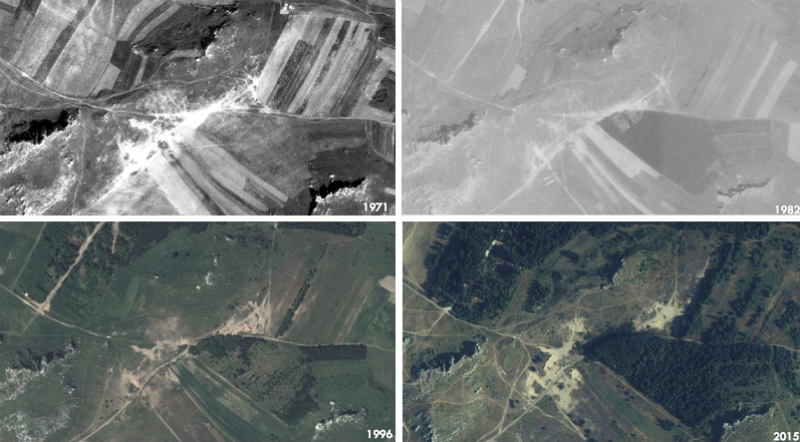Remote sensing to support the environment

Analysis of changes in woodlots and shrubs in the Ostoja Olsztyńsko-Mirowska area, ed. K. Osińska-Skotak
Business - Innovations – Technology
How can one check the condition of natural habitat? Hire a botanical expert who will go to the site and perform the necessary analyses. Unfortunately, it's time-consuming and expensive. However, there is a solution – use remote sensing. This was the case with the HabitARS project, which involved scientists from the Faculty of Geodesy and Cartography of the Warsaw University of Technology.
The aim of the project was to develop an innovative approach to support the monitoring of non-forest Natura 2000 habitats. Using remote sensing was expected to save time and money and also obtain an objective and repeatable method, independent from inherently subjective expert's assessments.
The results of the project could facilitate caring for biodiversity, and by extension for the condition of natural habitats. It is one of Poland’s obligations as a member state of the European Union.
The research was conducted in 37 areas: from the Biebrza Marshes and the Drawsko Forest in the north to the Bieszczady and Karkonosze Mountains in the south. Researchers picked such a large number of sites in order to account for climate variability and multiplicity of habitat types.
Call for cooperation
The HabitARS project involved several interrelated tasks. The first challenge was to integrate the work of several sensors on the remote sensing platform. It was also necessary to develop a methodology to identify non-forest Natura 2000 habitats located in agricultural areas, and then to develop a methodology to identify threats of desiccation, succession and alien invasive and expansive domestic plant species in these habitats. The last stage was to optimize the inventory and monitoring methodology.
To carry out all the tasks, the council leader – MGGP Aero sp. z o.o. – invited several universities and institutes to cooperate, including the Warsaw University of Technology.
Combating succession
“We were the leader of the task concerning the development of the succession hazard identification methodology in non-forest Natura 2000 habitats,” explains Prof. Katarzyna Osińska-Skotak, PhD, Eng., head of the project team from our University. “The methodology we have developed is highly automated. Based on the data from airborne laser scanning and hyperspectral photographs collected during a single flight (thanks to the remote sensing platform developed by MGGP Aero Sp. z o.o.), a mask for the range of trees and shrubs is made. It is then further analyzed to obtain information on whether these are forest areas or trees and shrubs entering habitat areas and to determine their species. The next step is to determine the extent to which a site or habitat is threatened by succession.
At this stage of analysis, further issues arise that are important for the methodology of identifying succession threats.
“Not all species of trees and shrubs are successive, the same species may behave differently in different habitats – they may pose a great threat to biodiversity in one and none at all in another,” Prof. Osińska-Skotak points out.
Her team from the Faculty of Geodesy and Cartography at the Warsaw University of Technology included specialists in photogrammetry and remote sensing, but not in botany. Therefore, the project task was carried out in cooperation with the University of Lodz. “The experts there were responsible for the botanical aspect, although the other botanical teams implementing the project, i.e. specialists from the Institute of Technology and Life Sciences and the University of Silesia in Katowice, were also verifying results in the field,” says Prof. Osińska-Skotak.
Different sources for a single purpose
In addition to current data, scientists also used archival resources. The oldest photos they managed to obtain date back to the 1970s. Thanks to such materials, it was possible to check how fast succession had progressed in the surveyed areas and to forecast what could happen if the preventive measures were not implemented.
As Prof. Osińska-Skotak points out, the aim of remote sensing is not to replace experts doing research in the field, but to support them. “These methods allow us to obtain a lot of data remotely, with which we can analyze various features and properties of a given object,” explains the researcher. “In our project, these include geometry, condition and species of tree or shrub. We had more than 200 photographs (so-called spectral bands) of the same object taken at the same time, but in different, very narrow ranges of radiation. In this way, we obtained detailed information allowing us to identify tree and shrub species. Their identification is influenced by a number of factors, including the time of a given flight. We analyzed this element within the project because the most economical solution would be to perform a single flight to obtain a map of succession species for a given area.
Using remote sensing methods particularly facilitates the management of large areas (such as Natura 2000) – the high costs of field research and their time consumption can be significantly reduced.
The entire HabitARS project involved approximately 80 people from seven institutions. The effects of their work will be available to the General Directorate for Environmental Protection, Regional Directorates for Environmental Protection, national and landscape parks, universities, NGOs, and investors among others.
Agnieszka Kapela
Promotion and Information Office
Project team from the Warsaw University of Technology: Prof. Katarzyna Osińska-Skotak, PhD, Eng. – team leader, Aleksandra Radecka, M.Sc., Wojciech Ostrowski, M.Sc., Krzysztof Bakuła, PhD, Eng., Łukasz Jełowicki, M.Sc., Konrad Górski, M.Sc., Jakub Charyton, Eng., Prof. Zdzisław Kurczyński, PhD, Eng., Joanna Pluto-Kosakowska, PhD, Eng., Przemysław Kupidura, PhD, Eng.
More about the project: http://habitars.pl/
Project duration: 2016-2019
Project lead: Łukasz Sławik (MGGP Aero sp. z o.o.)
Council members: MGGP Aero sp. z o.o. (leader), University of Lodz, University of Warsaw, Warsaw University of Life Sciences, Institute of Technology and Life Sciences, University of Silesia in Katowice, Warsaw University of Technology
“The innovative approach supporting monitoring of non-forest Natura 2000 habitats, using remote sensing methods” (project no.: DZP/BIOSTRATEG-II/390/2015) realized as part of the BIOSTRATEG II strategic program for research and development work “Natural environment, agriculture and forestry”, funded by the National Centre for Research and Development in Poland.








